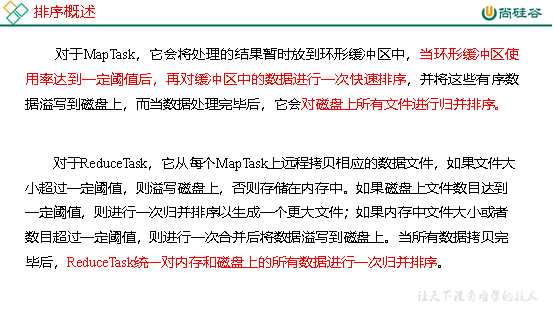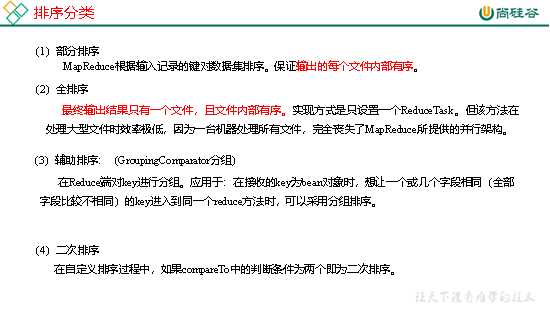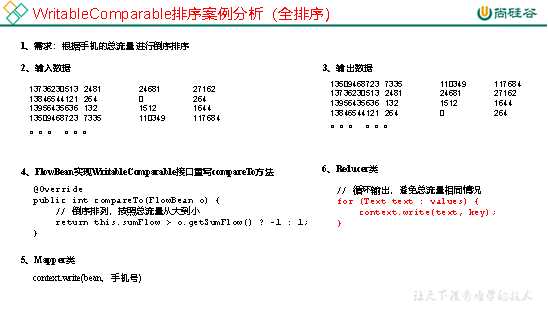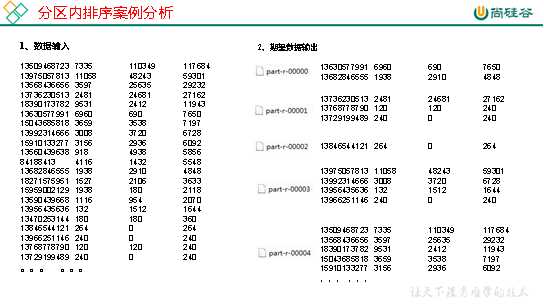标签:mapr string lib 序列 个数 else split mes table


1.排序的分类

2.自定义排序WritableComparable
(1)原理分析
bean对象做为key传输,需要实现WritableComparable接口重写compareTo方法,就可以实现排序。

@Override public int compareTo(FlowBean o) { int result; // 按照总流量大小,倒序排列 if (sumFlow > bean.getSumFlow()) { result = -1; }else if (sumFlow < bean.getSumFlow()) { result = 1; }else { result = 0; } return result; }
1.需求
根据案例2.3产生的结果再次对总流量进行排序。
(1)输入数据
原始数据 第一次处理后的数据


(2)期望输出数据
13509468723 7335 110349 117684
13736230513 2481 24681 27162
13956435636 132 1512 1644
13846544121 264 0 264
。。。 。。。
2.需求分析

3.代码实现
(1)FlowBean对象在在需求1基础上增加了比较功能
package com.atguigu.mapreduce.sort; import java.io.DataInput; import java.io.DataOutput; import java.io.IOException; import org.apache.hadoop.io.WritableComparable; public class FlowBean implements WritableComparable<FlowBean> { private long upFlow; private long downFlow; private long sumFlow; // 反序列化时,需要反射调用空参构造函数,所以必须有 public FlowBean() { super(); } public FlowBean(long upFlow, long downFlow) { super(); this.upFlow = upFlow; this.downFlow = downFlow; this.sumFlow = upFlow + downFlow; } public void set(long upFlow, long downFlow) { this.upFlow = upFlow; this.downFlow = downFlow; this.sumFlow = upFlow + downFlow; } public long getSumFlow() { return sumFlow; } public void setSumFlow(long sumFlow) { this.sumFlow = sumFlow; } public long getUpFlow() { return upFlow; } public void setUpFlow(long upFlow) { this.upFlow = upFlow; } public long getDownFlow() { return downFlow; } public void setDownFlow(long downFlow) { this.downFlow = downFlow; } /** * 序列化方法 * @param out * @throws IOException */ @Override public void write(DataOutput out) throws IOException { out.writeLong(upFlow); out.writeLong(downFlow); out.writeLong(sumFlow); } /** * 反序列化方法 注意反序列化的顺序和序列化的顺序完全一致 * @param in * @throws IOException */ @Override public void readFields(DataInput in) throws IOException { upFlow = in.readLong(); downFlow = in.readLong(); sumFlow = in.readLong(); } @Override public String toString() { return upFlow + "\t" + downFlow + "\t" + sumFlow; } @Override public int compareTo(FlowBean o) { int result; // 按照总流量大小,倒序排列 if (sumFlow > bean.getSumFlow()) { result = -1; }else if (sumFlow < bean.getSumFlow()) { result = 1; }else { result = 0; } return result; } }
(2)编写Mapper类
package com.atguigu.mapreduce.sort; import java.io.IOException; import org.apache.hadoop.io.LongWritable; import org.apache.hadoop.io.Text; import org.apache.hadoop.mapreduce.Mapper; public class FlowCountSortMapper extends Mapper<LongWritable, Text, FlowBean, Text>{ FlowBean bean = new FlowBean(); Text v = new Text(); @Override protected void map(LongWritable key, Text value, Context context) throws IOException, InterruptedException { // 1 获取一行 String line = value.toString(); // 2 截取 String[] fields = line.split("\t"); // 3 封装对象 String phoneNbr = fields[0]; long upFlow = Long.parseLong(fields[1]); long downFlow = Long.parseLong(fields[2]); bean.set(upFlow, downFlow); v.set(phoneNbr); // 4 输出 context.write(bean, v); } }
(3)编写Reducer类
package com.atguigu.mapreduce.sort; import java.io.IOException; import org.apache.hadoop.io.Text; import org.apache.hadoop.mapreduce.Reducer; public class FlowCountSortReducer extends Reducer<FlowBean, Text, Text, FlowBean>{ @Override protected void reduce(FlowBean key, Iterable<Text> values, Context context) throws IOException, InterruptedException { // 循环输出,避免总流量相同情况 for (Text text : values) { context.write(text, key); } } }
(4)编写Driver类
package com.atguigu.mapreduce.sort; import java.io.IOException; import org.apache.hadoop.conf.Configuration; import org.apache.hadoop.fs.Path; import org.apache.hadoop.io.Text; import org.apache.hadoop.mapreduce.Job; import org.apache.hadoop.mapreduce.lib.input.FileInputFormat; import org.apache.hadoop.mapreduce.lib.output.FileOutputFormat; public class FlowCountSortDriver { public static void main(String[] args) throws ClassNotFoundException, IOException, InterruptedException { // 输入输出路径需要根据自己电脑上实际的输入输出路径设置 args = new String[]{"e:/output1","e:/output2"}; // 1 获取配置信息,或者job对象实例 Configuration configuration = new Configuration(); Job job = Job.getInstance(configuration); // 2 指定本程序的jar包所在的本地路径 job.setJarByClass(FlowCountSortDriver.class); // 3 指定本业务job要使用的mapper/Reducer业务类 job.setMapperClass(FlowCountSortMapper.class); job.setReducerClass(FlowCountSortReducer.class); // 4 指定mapper输出数据的kv类型 job.setMapOutputKeyClass(FlowBean.class); job.setMapOutputValueClass(Text.class); // 5 指定最终输出的数据的kv类型 job.setOutputKeyClass(Text.class); job.setOutputValueClass(FlowBean.class); // 6 指定job的输入原始文件所在目录 FileInputFormat.setInputPaths(job, new Path(args[0])); FileOutputFormat.setOutputPath(job, new Path(args[1])); // 7 将job中配置的相关参数,以及job所用的java类所在的jar包, 提交给yarn去运行 boolean result = job.waitForCompletion(true); System.exit(result ? 0 : 1); } }
1.需求
要求每个省份手机号输出的文件中按照总流量内部排序。
2.需求分析
基于前一个需求,增加自定义分区类,分区按照省份手机号设置。

3.案例实操
(1)增加自定义分区类
package com.atguigu.mapreduce.sort; import org.apache.hadoop.io.Text; import org.apache.hadoop.mapreduce.Partitioner; public class ProvincePartitioner extends Partitioner<FlowBean, Text> { @Override public int getPartition(FlowBean key, Text value, int numPartitions) { // 1 获取手机号码前三位 String preNum = value.toString().substring(0, 3); int partition = 4; // 2 根据手机号归属地设置分区 if ("136".equals(preNum)) { partition = 0; }else if ("137".equals(preNum)) { partition = 1; }else if ("138".equals(preNum)) { partition = 2; }else if ("139".equals(preNum)) { partition = 3; } return partition; } }
(2)在驱动类中添加分区类
// 加载自定义分区类 job.setPartitionerClass(ProvincePartitioner.class); // 设置Reducetask个数 job.setNumReduceTasks(5);
标签:mapr string lib 序列 个数 else split mes table
原文地址:https://www.cnblogs.com/qiu-hua/p/13340949.html